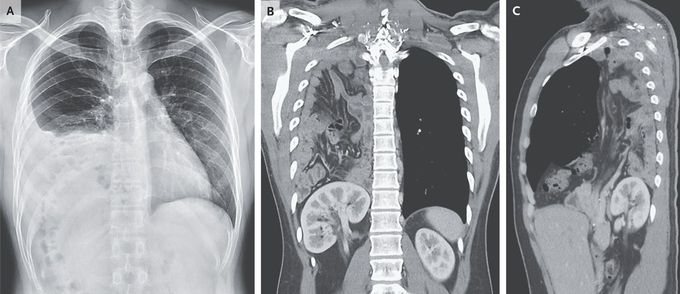


Congenital Diaphragmatic Hernia in an Adult
A 25-year-old man was referred to the emergency department owing to abnormal results on a chest radiograph obtained during a preemployment examination. He had no known medical history and no symptoms. His respiratory rate was 14 breaths per minute, and his oxygen saturation was 100% while he was breathing ambient air. On examination, there were decreased breath sounds at the base of the right lung. The abdomen was not tender. A radiograph of the chest showed a possible right pleural effusion, elevated right hemidiaphragm, and suspected translocation of the colon into the right upper quadrant of the abdomen (Panel A). Computed tomography of the chest with the use of contrast material revealed herniation of the right kidney, omentum, and small and large intestines into the right thoracic cavity through a large posterolateral diaphragmatic defect (Panel B shows the coronal view, and Panel C the sagittal view). There were no signs of bowel obstruction. A diagnosis of congenital diaphragmatic hernia due to a posterolateral diaphragmatic defect — also called a Bochdalek hernia — was made. Bochdalek hernia is typically diagnosed in infants and children, who present with respiratory distress. In rare cases, the hernia may remain asymptomatic until adulthood, at which time complications of bowel strangulation or obstruction may occur. The patient declined surgical repair of the diaphragmatic defect and was subsequently lost to follow-up.

